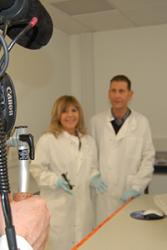Bang Goes the Theory comes to Bangor!
 Maggie Philbin and Professor Gary CarvalhoFollowing the recent furore over horse meat contamination in other meats, BBC’s popular science show, Bang Goes the Theory (on BBC 2 Wales at 18.30 on Tuesday 9 April 2013/ Monday 8 April 19..30 BBC One not in regions) looks at how new DNA techniques can be used to identify the fish on your plate.
Maggie Philbin and Professor Gary CarvalhoFollowing the recent furore over horse meat contamination in other meats, BBC’s popular science show, Bang Goes the Theory (on BBC 2 Wales at 18.30 on Tuesday 9 April 2013/ Monday 8 April 19..30 BBC One not in regions) looks at how new DNA techniques can be used to identify the fish on your plate.
Professor Gary Carvalho from Bangor University, shows presenter Maggie Philbin how the ability to identify the fish in her pie can help in safeguarding the consumer and safeguard all our fish stocks.
Prof Carvalho of the University’s School of Biological Sciences, led a major European network using the process of DNA Barcoding, coordinated as part of the Consortium for the Barcode of Life that aims to use DNA barcodes to identify all species on Earth. In addition, he coordinated a recently completed project, FishPopTrace, to develop tools that could analyse and recognise fish DNA to not only the type of fish, but to the population group it belongs to.
Up to a quarter of fish catches across the world are caught illegally. Globally, these illegal, unrecorded and unregulated fish catches amount to twice the value of catches by the European Union fishing fleet. These illegal fisheries undermine the sustainability of fish populations and efforts to produce a sustainable high-value fish market. Being able to identify illegal catches by species or capture location provides a valuable new source of forensic tools to tackle mislabelling and illegal fishing.
Prof Gary Carvalho explains:
“In safeguarding the sustainability of our fish stocks, a major existing problem is that it has not previously been possible to prove the exact origin of any particular fish, and in some circumstances, particularly with processed or cooked fish, it can be quite difficult even to identify the species, let alone its source of origin.
“We have developed a method that can be used throughout the food supply chain and across the fish industry, and have shown its effectiveness in four common European species.
The tools can be used to identify or compare a set of pre-identified genetic markers within fish samples at any point in the consumer chain from net to plate, and to trace the fish back to their region of origin or breeding group”
With the use of these tools, consumers will be able to purchase fish, confident in the knowledge that they are buying or eating the product described on the label or the menu and that their purchases are from sustainable fish stocks.”
Publication date: 4 April 2013
